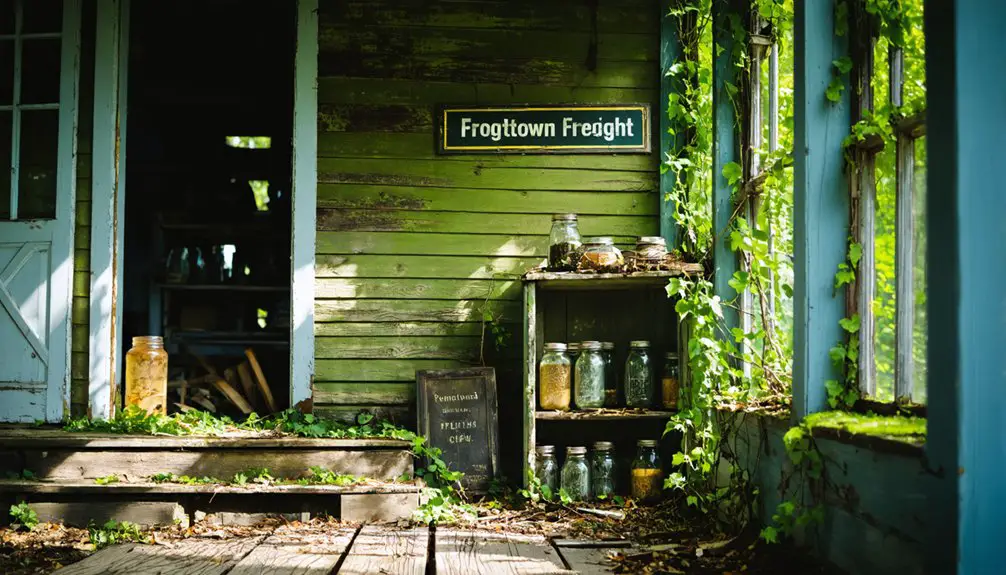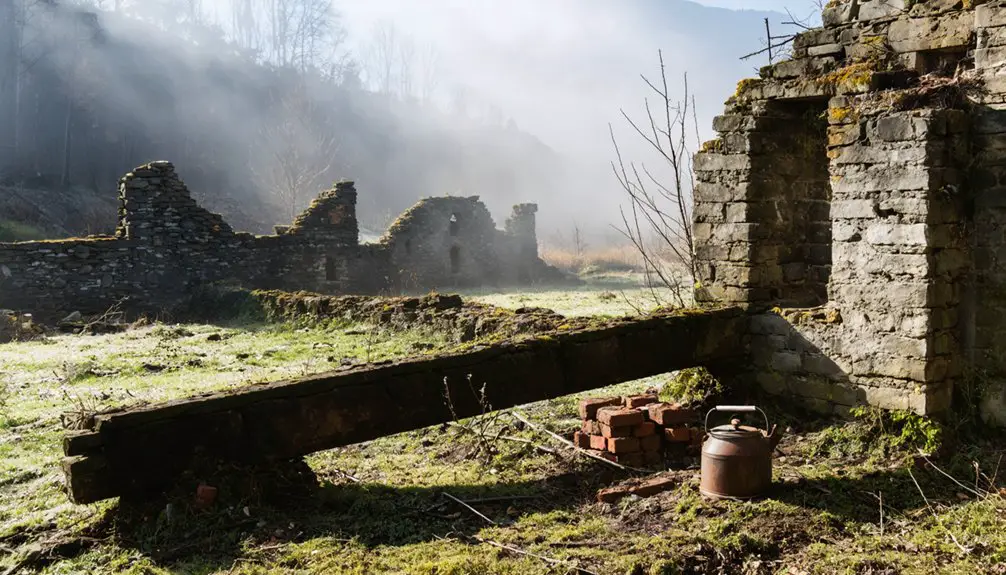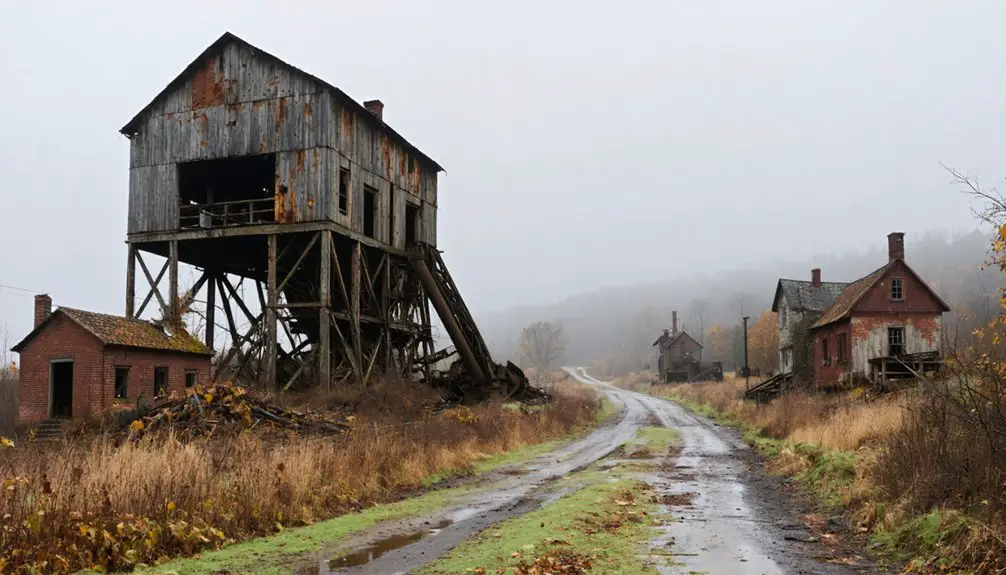You’ll find Frogtown along the Monongahela River, where a bustling mining settlement once housed 2,700 residents in the mid-1800s. The town emerged when 400 acres of farmland transformed into an industrial hub, drawing immigrant workers from Wales, Scotland, Ireland, and Eastern Europe. Today, this Pennsylvania ghost town stands abandoned, with only crumbling foundations and overgrown paths remaining. The town’s haunting remnants tell a deeper story of America’s coal mining heritage.
Key Takeaways
- Frogtown emerged as a mining settlement in the mid-1700s along the Monongahela River, transforming 400 acres into an industrial hub.
- The town thrived with a diverse immigrant population from Wales, Scotland, Ireland, and Eastern Europe, reaching nearly 3,000 residents.
- Commercial coal mining operations began in the 1840s, with extensive rail networks established by the Lehigh Valley Coal Company.
- A residential trash fire in 1962 ignited underground coal seams, leading to toxic conditions and massive population decline.
- The population dropped from 2,700 to fewer than five residents, leaving behind crumbling infrastructure reclaimed by nature.
The Rise of a Mining Community
As Pennsylvania’s coal industry flourished in the mid-1700s, Frogtown emerged as one of many bustling mining settlements along the resource-rich Monongahela River in Greene County.
You’d have witnessed rapid community development as coal companies transformed 400 acres of farmland into a thriving industrial hub, complete with mining shafts, processing plants, and worker housing.
Like many coal towns of the era, Frogtown’s growth exploded with the arrival of an immigrant workforce from Wales, Scotland, Ireland, and Eastern Europe.
The company built essential infrastructure including schools, churches, and stores to support these miners and their families.
The miners living in Frogtown resided in company-maintained duplexes while taking responsibility for their own lawns and gardens.
A network of railroad lines connected Frogtown to steel mills and power plants, while the town’s strategic location near rich coal seams guaranteed its place in Pennsylvania’s booming industrial landscape.
The miners faced significant health risks, with many developing black lung disease from prolonged exposure to coal dust in the mines.
Life in Pennsylvania Coal Country
If you’d lived in Frogtown during its mining heyday, your family’s daily routine would have revolved entirely around the mine whistles that signaled shift changes and emergencies.
You’d have watched your coal-dusted father trudge home after grueling underground shifts, his body exhausted from hours of picking and hauling coal in cramped, dangerous conditions.
Your mother would have spent her days managing the constant coal dust that coated every surface in your company-owned house, while possibly taking in boarders or laundry work to supplement the family’s meager mining wages.
Like many mining towns of the era, Frogtown’s diverse immigrant communities formed tight-knit neighborhoods where traditions from the old country helped sustain families through hardship.
On productive days, your father might earn extra by mining up to ten tons of coal, though much of his earnings went to rent and company store deductions.
Daily Mining Family Routines
Life for Pennsylvania coal mining families in the late 19th and early 20th centuries revolved around the mine’s demanding schedule.
You’d wake before sunrise, around 4 a.m., to prepare for your 10-12 hour shift. After donning heavy woolen clothes and leather boots, you’d walk to the mine entrance at the sound of the morning whistle. Underground, miners relied on carbide lamps for light as they worked in the dark passages. The physical toll was extreme, requiring forty swings per minute with a pickaxe to extract coal.
Your wife’s daily mining routines included washing your coal-dusted clothes and delivering food during your shift.
Family dynamics centered on survival, with children often contributing as breaker boys or mule drivers.
After work, you’d stop at the communal washhouse to clean up before entering your modest company house, where you’d gather around the coal stove for warmth.
Despite the harsh conditions, strong bonds formed between mining families who shared these daily struggles together.
Coal Culture and Community
During the late 19th and early 20th centuries, Pennsylvania’s coal communities forged a distinct cultural identity shaped by immigrant traditions, shared labor, and collective struggle.
You’d find these tight-knit communities filled with Welsh, Irish, Scottish, and Eastern European families, each bringing their own ethnic traditions and cultural festivals to enliven the demanding coal town life.
The heart of these communities beat in union halls, churches, and mutual aid societies, where you’d witness the blending of Old World customs with new American working-class solidarity.
Despite the harsh realities of mining life – black lung disease, workplace accidents, and labor disputes – these communities remained resilient.
They created their own social support networks, preserved their heritage through music and celebrations, and fought together for better working conditions through collective action and union organizing. In 1920, many immigrant miners were required to attend Americanization schools to assimilate into the local culture.
The growth of these communities paralleled the expansion of the steel industry, as Pittsburgh’s coal consumption reached over 400 tons daily by 1830.
Economic Foundations and Industry
Throughout Pennsylvania’s coal country, Frogtown exemplified the boom-and-bust cycle of mining towns that relied on anthracite extraction and railroad transport.
You’d find miners working deep underground in shafts operated by prominent companies like the Lehigh Valley Coal Company, which established extensive rail networks to move coal to market. The arrival of the first railroad line in 1854 revolutionized coal transport from the mines.
Your ancestors might’ve witnessed the town’s peak economic activity in the late 1800s, when coal breakers processed thousands of tons daily while horse-drawn wagons and steam locomotives carried the valuable mineral to industrial centers across the Northeast. The town’s population followed similar patterns to other mining communities, reaching nearly 3,000 people during its most prosperous period.
Coal Mining Operations
Commercial coal mining emerged in Frogtown and the broader Cambria County region during the 1840s, with pioneering operations like the Myers brothers’ and Samuel Lemon’s mines established in 1845 near Summit.
These early mines tapped into rich bituminous coal seams using drift and shaft mining techniques, which required miners to work in narrow, low-ceilinged tunnels supported by wooden beams.
You’ll find that mining techniques remained largely unchanged until mechanization, with miners using basic hand tools like picks and shovels to extract coal from underground veins.
The region’s high-quality bituminous coal proved ideal for coking and steelmaking, making it essential to the iron industry’s growth.
Miners endured hazardous conditions, including coal dust, methane gas risks, and the physical demands of working in hot, cramped underground spaces.
Transportation and Trade Routes
As Frogtown evolved from a mining settlement into an essential transportation hub, its network of roads, rails, and waterways shaped the region’s economic destiny.
You’ll find evidence of this transportation evolution in the 1929 paving of routes connecting Frogtown to Jones Mills, and later highway developments that linked the town to Interstate 70.
The town’s strategic position along the Burlington Northern Santa Fe Railroad made it a significant junction in Pennsylvania’s trade networks.
The Jackson Street Roundhouse complex supported critical railroad operations, while University Avenue became a bustling commercial corridor.
You can trace the layers of progress from early dirt roads and bridal paths to paved highways, and from the historic Saint Paul and Pacific Railroad to modern industrial rail lines serving Marcellus shale operations.
The Beginning of the End
When a residential trash fire ignited an underground coal seam in May 1962, no one could have predicted it would spell doom for the thriving mining town of Centralia.
The community’s resilience was tested as environmental hazards grew increasingly severe, forcing residents to face an impossible choice: stay or leave their beloved homes.
- Initial containment efforts failed miserably, with frozen water lines and ineffective trenching attempts wasting precious time and resources.
- By the early 1980s, toxic gases and ground instability created life-threatening conditions throughout the town.
- A controversial fly ash barrier project in 1969 proved futile when the fire breached it by 1972, crushing hopes of controlling the underground inferno.
The disaster would transform this once-vibrant mining community of 2,700 residents into a haunting reminder of nature’s unstoppable force.
Ghost Town Transformation

Through decades of devastating environmental and economic decline, Centralia’s transformation into a ghost town represents one of Pennsylvania’s most striking examples of post-industrial collapse.
You’ll find that ghost town economics took hold as property values plummeted and federal buyouts encouraged an exodus, reducing the population from 1,200 to fewer than five residents.
Yet cultural resilience emerged in unexpected ways. The abandoned Route 61 became the iconic “Graffiti Highway,” drawing artists and photographers until its burial in 2020.
From desolation sprung art, as the abandoned asphalt of Route 61 evolved into a canvas for creative expression.
The town’s eerie atmosphere inspired creative works, especially the horror film “Silent Hill.”
Despite safety concerns from the ongoing underground fire, Centralia continues attracting dark tourism enthusiasts, transforming from a thriving mining community into a hauntingly popular cultural landmark.
Physical Remnants Today
Despite decades of abandonment, Frogtown’s physical remnants paint a haunting portrait of post-industrial decline.
You’ll witness nature’s steady reclamation as vegetation gradually overtakes the crumbling infrastructure. The town’s physical decay manifests in tilted tombstones, buckling streets, and the skeletal remains of homes and businesses that once thrived here.
- Warped foundations and stone walls stand as silent sentinels, while metal vent pipes pierce the ground, releasing pressure from underground disturbances.
- Cemeteries remain among the few maintained spaces, though their “wonky” headstones reveal the unstable earth below.
- Roads narrow under nature’s advance, while abandoned buildings surrender to the elements, their deteriorating frames marking time’s relentless march through this forgotten Pennsylvania hamlet.
Legacy and Historical Impact

As a stark symbol of Pennsylvania’s coal mining heritage, Centralia’s enduring legacy transcends its physical ruins.
You’ll find its impact woven deeply into regional identity, serving as a sobering reminder of both community resilience and environmental challenges faced by mining towns.
The town’s story has influenced modern mining regulations and disaster response protocols, while setting precedents for government intervention in environmental displacement.
You can trace its cultural footprint through various media adaptations, including the famous “Silent Hill” franchise and numerous documentaries.
Beyond entertainment, Centralia’s ongoing underground fire provides valuable data for environmental scientists studying coal fire behavior and toxic emissions.
The town’s narrative continues to shape discussions about post-industrial decline, property rights, and the delicate balance between industrial progress and environmental stewardship.
Exploring the Abandoned Site
When exploring Frogtown today, you’ll encounter a haunting tableau of Pennsylvania’s industrial past nestled within the Appalachian terrain.
As an urban exploration destination, the site reveals the stark reality of America’s declining coal towns through its abandoned structures and industrial remnants. While historical preservation efforts remain minimal, the location offers a raw glimpse into the region’s coal mining heritage.
If you’re planning to visit, remember these essential points:
- Access is via rural roads, but you must respect private property boundaries and posted warnings.
- Watch for hazards like unstable ground, toxic emissions, and deteriorating structures.
- Document any visible coal-related artifacts, including coke ovens or ventilation equipment, as they’re valuable historical records.
Preserving Mining Heritage

The preservation of Frogtown’s mining heritage stands as an essential undertaking in Cambria County, where coal extraction shaped the region’s industrial identity since the mid-1800s.
You’ll find heritage conservation efforts focused on balancing environmental challenges with historical significance, as the site represents both Pennsylvania’s industrial might and its complex legacy of abandoned mine lands.
Through mining education programs at nearby institutions like the Heritage Discovery Center, you can explore artifacts, oral histories, and interactive exhibits that bring to life the immigrant workers’ experiences, labor struggles, and technological advances.
The preservation work doesn’t just protect physical remnants – it safeguards the stories of company towns, wage disputes, and community resilience that defined the era.
These efforts guarantee future generations understand coal’s pivotal role in shaping local culture and American industry.
Frequently Asked Questions
Why Was the Settlement Named Frogtown?
You’ll find Frogtown’s origins tied to the abundant frogs in its marshy wetlands. The naming significance reflects early settlers’ practice of identifying places by their distinctive wildlife and natural characteristics.
Are There Any Known Accidents or Mining Disasters Specific to Frogtown?
While Pennsylvania saw hundreds of mining deaths between 1899-1907, you won’t find any documented accidents or mining disasters specific to Frogtown in official registers, state archives, or historical records.
What Was the Peak Population of Frogtown During Its Mining Heyday?
You’ll find that Frogtown’s demographics peaked between 1890-1900, when the mining industry brought about 2,700 to 2,761 residents to this bustling neighborhood within Centralia’s thriving coal community.
Did Frogtown Have Its Own School System or Church Buildings?
While you might assume Frogtown had a complete school system, records don’t confirm this. However, you’ll find at least one church building and cemetery that’ve survived, even as the town declined from mining’s heyday.
Are There Any Local Legends or Ghost Stories Associated With Frogtown?
You won’t find documented haunted locations or spectral sightings specific to this area. Unlike other Pennsylvania ghost towns with rich supernatural folklore, there aren’t any verified local legends surviving about this settlement.
References
- https://pabucketlist.com/the-rise-and-fall-of-centralia-pas-toxic-ghost-town/
- https://www.youtube.com/watch?v=Qj5LjacccJ0
- https://www.jeffreydonenfeld.com/blog/2009/12/exploring-the-ghost-town-of-centralia-pennslvania/
- https://en.wikipedia.org/wiki/List_of_ghost_towns_in_Pennsylvania
- https://uncoveringpa.com/visiting-centralia
- https://newsinteractive.post-gazette.com/coal-towns/
- https://philadelphiaencyclopedia.org/essays/coal/
- https://www.iup.edu/library/departments/archives/coal/coal-culture-timeline.html
- https://raystown.org/blog/post/coal-mining-a-hard-knock-life/
- https://www.pa.gov/agencies/dep/programs-and-services/mining/abandoned-mine-reclamation/aml-program-information/pas-mining-legacy-and-aml.html



